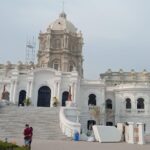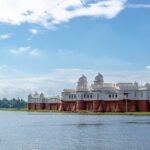Share
With a population of just under 100,000, Thimphu is not only the capital but also the largest and most populous city in Bhutan. The urban agglomeration is located on the western hills of the wang chu valley, at the height of over 2,300 meters above sea level.
Despite being at the same latitude as Miami and Cairo, Thimphu has a very different climate from that of the other metropolises due to the attitude, which keeps temperatures at fairly low values.
In January the values fluctuate on average between -3 and 12 degrees, even if there are not rare nights at -7/-8 degrees. In summer the highs exceed a few degrees above the 20 degrees mark, while the minimum hardly falls below 15 degrees.
The rapid urbanization of Thimphu in recent years has considerably increased the size of the settlement, the state’s main economic and political center.
A peculiarity is linked with the fact that Thimphu is the only capital in the world where traffic lights do not exist, since, after the attempt by the local authorities to install some, the population protested by judging them to be impersonal and demanded that they are removed at once.
Therefore, you could imagine the traffic conditions, which is currently being governed exclusively by the theatrical gestures of the white brigade fighters. In another light, the white brigade fighters are real points of attraction of the region that almost no tourists let escape the lens of their camera.
Before the new road was completed in 1962, it took about ten days to reach the capital from the Phuentsholing; now six hours are enough. For the rest, once you have landed at the only airport in the country, Paro airport, you can take a taxi or rent a car to reach Thimphu, which is 53 kilometers away and a couple of hours away by a car.
The best way to move around the city is undoubtedly your legs, with which you will avoid the sudden traffic jams caused by the lack of traffic lights.
Several archaeological findings suggest that the area of Thimphu must have been inhabited as early as 2,000 BC when nomadic populations have been staying there to hunt.
The influence of Buddhism which began to spread among the population starting from the 2nd century AD was very important for the city, which still sees the presence of enchanting temples and ancient monasteries.
10 Things To Do In Thimphu
-
Visit the Trashi chhoe Dzong
The Trashi chhoe Dzong is one of the symbolic attractions of the capital of Bhutan. The site, built on the western shore of Wang Chhu, does not overlook the valley or the city as a real fortress but, on the contrary, its wonderful portions and its modest give it a remarkable magnificence the external structures are two stories high and is covered with a thin layer of plaster, while at the four corners there are three- story towers with red and golden roofs that jut out over the walls .
Unlike most decades, the headquarters of the secretariat, the throne room and other offices of the king, as well as the ministry of the interior and finance have been located within the complex.
-
Explore the National Memorial Chorten,
This is a large Tibetan style memorial site built in 1974 in memory of the third king Jigme Dorji Wangchuck. It also comes as a great point of visit for all tourists.
-
Visit the Changlimithang Stadium
The Changlimithang Stadium stands as the national stadium of Thimphu, as it houses the archery range, a large football stadium, a basketball court, and several tennis and squash courts.
-
Explore the SAARC Building
The SAARC Building a large Bhutanese style building which was set up in the 1990s on the eastern bank of the river to host a meeting of heads of state from various South Asian countries held by the SAARC ( South Asia Association for Regional Co-operation).
-
Visit the National Institute for Zorig Chusum
The National Institute for Zorig Chusum commonly called ” the painting school ” stands as a testimony to the high cultural level reached by Thimphu in recent years. This also comes as a delight because it provides students from all over the state with a four/six-year course that gives a complete artistic preparation.
-
Visit the National Institute of Traditional Medicine
The National Institute of Traditional Medicine is one of the most particular structures in the city, in which medicines based on medicinal herbs and other preparations are prepared.
-
Visit the Thimphu museums
In Thimphu, there are several interesting museums scattered around the capital, such as the Folk Heritage Museum, the ” Museum of Popular Traditions,” housed in a building made of pressed mud and wood.
This tends to be an imitation of the typical Bhutanese rural houses, and the National Textile Museum used for the dissemination of the local art of weaving.
-
Explore the Thimphu National Library
In this list of ideal things to do in Thimphu, we can also fully insert the National Library, established in 1967 to preserve ancient texts in Dzongkha and Tibetan languages.
-
Visit the traditional weekend market
Many tourists define the traditional weekend market as one of the most interesting and curious attractions of Thimphu. Starting Thursday evening and until Sunday, hawkers from all over the regions enliven the shores of Wang Chhu immediately north of Changlimithang Stadium with stalls laden with food of all kinds, depending on the season, including fruits, vegetables, meat, and cheese.
Between one banquet and another, smells and flavors will stimulate your senses in a sublime way, and also enticing the reticent visitor to try some Bhutanese delicacies.
-
Explore the Motithang Takin Preserve


